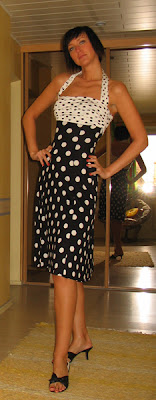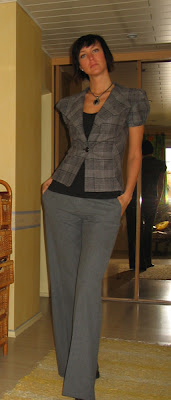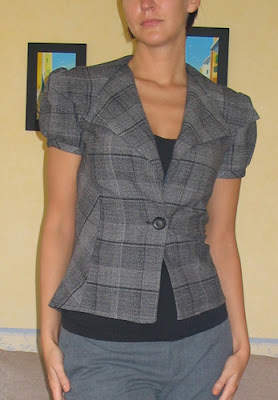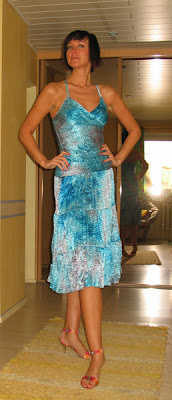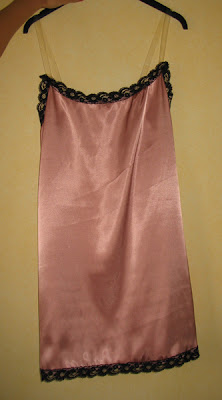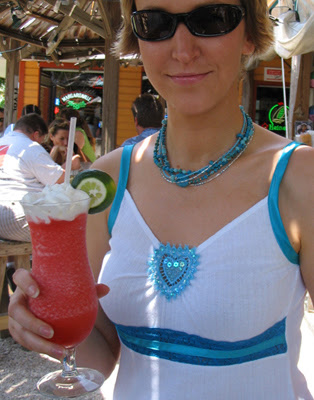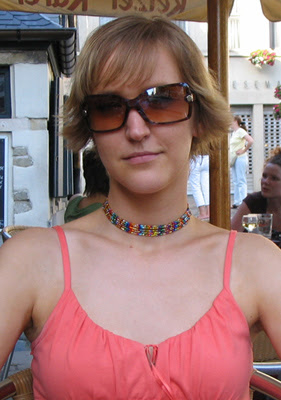 I promised to make a step-by-step ‘how-to’ for the polkadot dress and here it is. I wanted to simply make another dress for myself as I took the photos of each step but was unable to locate any suitable fabrics. Yeah, shopping with a particular taste is not the easiest around here. ;) But, I made a drawing for each step and I hope they are clear enough. If anything remains shady, then do not hesitate to ask and I will explain it further! I hope I did not forget anything and that you will enjoy making AND wearing this dress as much as I have! ;) And as soon as I locate fabrics I like, I will exchange the drawings for photos! Also, if you come up with any cool additions, tricks of the trade or something like that yourself, then do share the knowledge. ;) This is simply my version of how to do a dress like this.
I promised to make a step-by-step ‘how-to’ for the polkadot dress and here it is. I wanted to simply make another dress for myself as I took the photos of each step but was unable to locate any suitable fabrics. Yeah, shopping with a particular taste is not the easiest around here. ;) But, I made a drawing for each step and I hope they are clear enough. If anything remains shady, then do not hesitate to ask and I will explain it further! I hope I did not forget anything and that you will enjoy making AND wearing this dress as much as I have! ;) And as soon as I locate fabrics I like, I will exchange the drawings for photos! Also, if you come up with any cool additions, tricks of the trade or something like that yourself, then do share the knowledge. ;) This is simply my version of how to do a dress like this. Measuring yourself:
Measuring yourself:Well, as you can see from the photo, then one needs to measure above the chest, under it, the waist, hips, height of the chest panels, distance to the waist and the overall length of the dress from under the chest. And then the length of the neck-strap from under the chest on one side to the same place on the other side.
Fabric:
My dress is made of really soft jersey. That way I did not have to worry about making the chest piece fit, since the stretching will do it for me. If you decide to make it of two different fabrics, then make sure they would be of approximately the same weight and texture. Although, a red fake fur chest piece would be preeetty darn cool! ;) I usually take a drawing of the dress and the measurements to the shop when I go to get the fabric. Any shop assistant should be able to tell you the amount of fabric needed.
 The pieces of the pattern (I usually use old newspapers) you will need:
The pieces of the pattern (I usually use old newspapers) you will need:1. Back of the chest piece, 2x chest length, half of the (under)chest width.
2. Front of the chest piece, 2x chest length + some extra (about 10 cm) for rouching, half of the (under)chest width. The width of the two chest pieces together should be the circumference under the chest.
3. 2 dress’s side panels.
4. Dress’s front/back panel.
5. Neck-strap, length of the neck strap and about 12 cm wide.
Getting the width of the dress panels:
First divide the under chest measurement by 2 (this should also be the width of the chest piece), then see what would be a good ratio for the front/back and side panels. On my dress the front/back panel is roughly 1,6 times wider than the side panels. So: my under chest measurement was (at its widest, while freely breathing in) 80 cm. I made the side panels 10 cm at the top, and front/back is 16 cm. That is after I fitted the dress on me, and took it in a little since the fabric IS stretchy and it did not need to be all that wide. But when making the pieces, rather have a little more. Then you just use the same ratio for the other measurements: waist and hips and draw them that wide at those places. The waist should be at the distance from the top as you measured (distance to the waist from under the chest) and since the dress is rather flowing over the hips, you simply need to make sure that the hips can fit in there. Length of the dress panels is as you measured from under the chest.
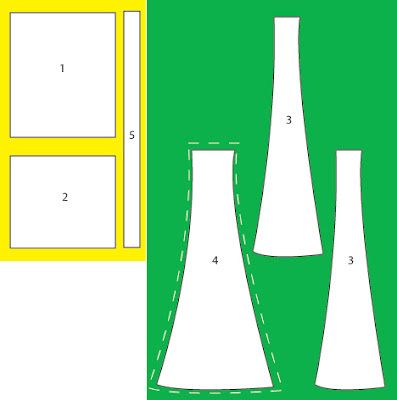 Arranging the pattern on the fabric:
Arranging the pattern on the fabric:First of all: fold the dress fabric (green) length-wise, so you now get two front/back pieces at once, when cutting. Then arrange the dress panels on the fabric (you need to end up with 2 front/back panels and 4 side panels). Put them all facing the same direction, do not turn any of them upside down. Because if you have a patterned fabric, it could make a difference in how the pattern runs and also how the fabric will eventually fall on you. It is just safer this way. Depending on the size of the dress and the width of the fabric one should need around 1,5 times the length of the dress panel piece for the dress and about the neck-strap length piece for the chest. Do your math, though and if in doubt ask the people at the fabric shop. Heaven knows, I always harass those people with questions like that! And be on the safe side, it is better to have a little left over. :) Also, leave around 2-3 cm in between all the pieces. That is for the extra room for sewing etc. Fasten the pattern to the fabric with bobby pins. Make sure you measure everything 10 times. Also, make sure that the stretchiness is in the right direction – horizontal across your chest, across the midriff etc. Only then cut about 1 to 1,5 cm from the pattern (like along the dotted line).
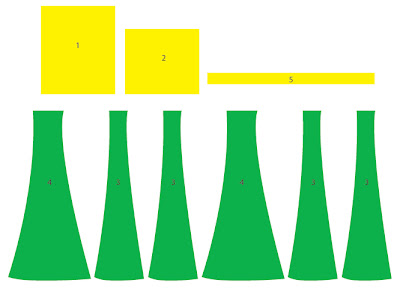 Sewing:
Sewing:Now you should have 6 panels, including 2 front/back panels and 4 side panels, 2 chest pieces, one of which is 10 cm longer than the other and a neck-strap.
Arrange them before you as on the picture and first of all sew together the sides of the dress panels. 2 side panels in between the front/back panels. Try it on! Make sure that it fits you nicely (under the chest!!!), that it is not too wide, not too tight, perhaps it needs to be tightened here, let out there, make sure the dress part is perfect on you.
 Rouching:
Rouching:Fold the front chest piece over so one side is the exact length of what you measured the chest piece should be. Then arrange the longer side into folds, rouches, whatever you prefer (along the dotted line). Make it the same length as the other side with the rouching and sew through the dotted line to keep the folds in place. Do NOT sew the two sides together. You should end up with 2 chest pieces, that are the same height now (2x measured chest height) and one of them is half way rouched.
 Attaching the chest piece to the dress:
Attaching the chest piece to the dress:Now take the front rouched chest piece and put it to the dress so that the rouching is at the seam and so that the front panel is in the middle of the front of the dress, with the 2 side panels on either side. It should be about the right width, with a little bit of the chest piece hanging over on either side (the sewing room). Sew it to the dress part along the red line. Do it by hand at first if the fabric is really stretchy or if the rouching could get in the way.
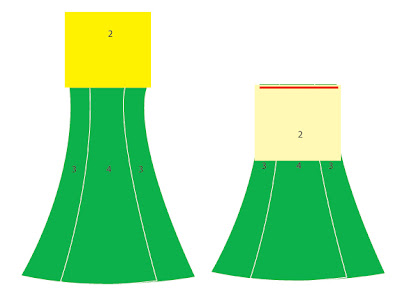 Do the same with the back side.
Do the same with the back side. Sewing the sides of the chest pieces:
Sewing the sides of the chest pieces:First see, that you have something similar to what is on the drawing. Then turn the dress inside out and sew together the sides of the chest pieces. Once again, make sure that the rouching stays intact, so a little manual labour might be needed before going under the machine. So, basically it should eventually be that the red lines and turquoise lines are seams.
 Hand sewing:
Hand sewing:Now comes the tough part. You will have to fold down the double of the chest length, into the dress, and sew it by hand to the dress. Make it as neat as possible. It is not going to show, but you want it to be safely fastened and also not showing from the right side of the dress. Hence also no machinery for this part. The seam has to be completely invisible when you turn the right side out.
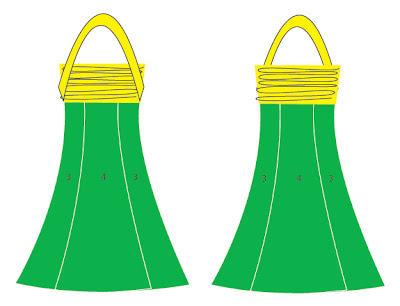 Neck-strap:
Neck-strap:First sew the one long open side of the neck-strap together thusly forming a looong tunnel. Turn it inside out and you have the neck-strap. Now, since the dress is all nice and neat at the top, you do not really want to go messing that up with the neck-strap, pulling and stretching at all the wrong places. So, what I did was I attached it to the seam where the chest piece meets the dress piece. And right in the middle of the two side panels, so the neck-strap comes from pretty much my under-arms. Try different locations, if you prefer. The first drawing is to show where the neck-strap attaches to the dress and the second is how it should look, once you have sewn the neck-strap to its place (by hand!!!, so there are no visible seams on the right side of the dress). If you want to, you can also attach the chest piece to the neck-strap with a couple of stitches closer to the top of the chest piece as well. Mine is snug enough, so it did not need it, stays up all by itself as well. ;)
Hemming:
Now, all there is left over to be done is the hem of the dress. Turn it back once and definitely hand sew loosely first as the fabric is stretchy. Try not to stretch it too much under the machine and it should be alright.
Hopefully the explanations were clear enough. If not, then DO feel free to ask for clarifications. If you decide to make this dress then I wish you the very best of luck and definitely let me know how it turned out and send me photos through my profile! I will be posting them as well, if you want me to!
I hope it works out!!! Best of luck and break a needle. ;)
